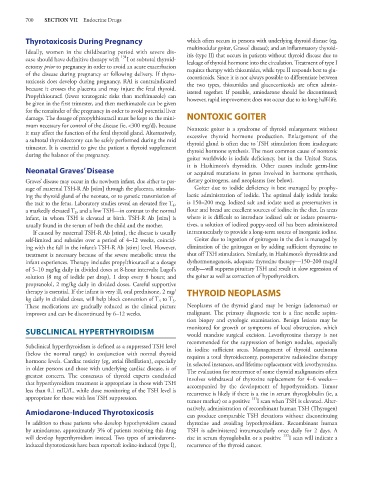Page 714 - Basic _ Clinical Pharmacology ( PDFDrive )
P. 714
700 SECTION VII Endocrine Drugs
Thyrotoxicosis During Pregnancy which often occurs in persons with underlying thyroid disease (eg,
multinodular goiter, Graves’ disease); and an inflammatory thyroid-
Ideally, women in the childbearing period with severe dis- itis (type II) that occurs in patients without thyroid disease due to
131
ease should have definitive therapy with I or subtotal thyroid- leakage of thyroid hormone into the circulation. Treatment of type I
ectomy prior to pregnancy in order to avoid an acute exacerbation requires therapy with thioamides, while type II responds best to glu-
of the disease during pregnancy or following delivery. If thyro- cocorticoids. Since it is not always possible to differentiate between
toxicosis does develop during pregnancy, RAI is contraindicated the two types, thioamides and glucocorticoids are often admin-
because it crosses the placenta and may injure the fetal thyroid. istered together. If possible, amiodarone should be discontinued;
Propylthiouracil (fewer teratogenic risks than methimazole) can however, rapid improvement does not occur due to its long half-life.
be given in the first trimester, and then methimazole can be given
for the remainder of the pregnancy in order to avoid potential liver
damage. The dosage of propylthiouracil must be kept to the mini- NONTOXIC GOITER
mum necessary for control of the disease (ie, <300 mg/d), because Nontoxic goiter is a syndrome of thyroid enlargement without
it may affect the function of the fetal thyroid gland. Alternatively, excessive thyroid hormone production. Enlargement of the
a subtotal thyroidectomy can be safely performed during the mid thyroid gland is often due to TSH stimulation from inadequate
trimester. It is essential to give the patient a thyroid supplement thyroid hormone synthesis. The most common cause of nontoxic
during the balance of the pregnancy.
goiter worldwide is iodide deficiency, but in the United States,
it is Hashimoto’s thyroiditis. Other causes include germ-line
Neonatal Graves’ Disease or acquired mutations in genes involved in hormone synthesis,
Graves’ disease may occur in the newborn infant, due either to pas- dietary goitrogens, and neoplasms (see below).
sage of maternal TSH-R Ab [stim] through the placenta, stimulat- Goiter due to iodide deficiency is best managed by prophy-
ing the thyroid gland of the neonate, or to genetic transmission of lactic administration of iodide. The optimal daily iodide intake
the trait to the fetus. Laboratory studies reveal an elevated free T , is 150–200 mcg. Iodized salt and iodate used as preservatives in
4
a markedly elevated T , and a low TSH—in contrast to the normal flour and bread are excellent sources of iodine in the diet. In areas
3
infant, in whom TSH is elevated at birth. TSH-R Ab [stim] is where it is difficult to introduce iodized salt or iodate preserva-
usually found in the serum of both the child and the mother. tives, a solution of iodized poppy-seed oil has been administered
If caused by maternal TSH-R Ab [stim], the disease is usually intramuscularly to provide a long-term source of inorganic iodine.
self-limited and subsides over a period of 4–12 weeks, coincid- Goiter due to ingestion of goitrogens in the diet is managed by
ing with the fall in the infant’s TSH-R Ab [stim] level. However, elimination of the goitrogen or by adding sufficient thyroxine to
treatment is necessary because of the severe metabolic stress the shut off TSH stimulation. Similarly, in Hashimoto’s thyroiditis and
infant experiences. Therapy includes propylthiouracil at a dosage dyshormonogenesis, adequate thyroxine therapy—150–200 mcg/d
of 5–10 mg/kg daily in divided doses at 8-hour intervals; Lugol’s orally—will suppress pituitary TSH and result in slow regression of
solution (8 mg of iodide per drop), 1 drop every 8 hours; and the goiter as well as correction of hypothyroidism.
propranolol, 2 mg/kg daily in divided doses. Careful supportive
therapy is essential. If the infant is very ill, oral prednisone, 2 mg/ THYROID NEOPLASMS
kg daily in divided doses, will help block conversion of T to T .
3
4
These medications are gradually reduced as the clinical picture Neoplasms of the thyroid gland may be benign (adenomas) or
improves and can be discontinued by 6–12 weeks. malignant. The primary diagnostic test is a fine needle aspira-
tion biopsy and cytologic examination. Benign lesions may be
SUBCLINICAL HYPERTHYROIDISM monitored for growth or symptoms of local obstruction, which
would mandate surgical excision. Levothyroxine therapy is not
recommended for the suppression of benign nodules, especially
Subclinical hyperthyroidism is defined as a suppressed TSH level in iodine sufficient areas. Management of thyroid carcinoma
(below the normal range) in conjunction with normal thyroid requires a total thyroidectomy, postoperative radioiodine therapy
hormone levels. Cardiac toxicity (eg, atrial fibrillation), especially in selected instances, and lifetime replacement with levothyroxine.
in older persons and those with underlying cardiac disease, is of The evaluation for recurrence of some thyroid malignancies often
greatest concern. The consensus of thyroid experts concluded involves withdrawal of thyroxine replacement for 4–6 weeks—
that hyperthyroidism treatment is appropriate in those with TSH accompanied by the development of hypothyroidism. Tumor
less than 0.1 mIU/L, while close monitoring of the TSH level is recurrence is likely if there is a rise in serum thyroglobulin (ie, a
appropriate for those with less TSH suppression. 131
tumor marker) or a positive I scan when TSH is elevated. Alter-
Amiodarone-Induced Thyrotoxicosis natively, administration of recombinant human TSH (Thyrogen)
can produce comparable TSH elevations without discontinuing
In addition to those patients who develop hypothyroidism caused thyroxine and avoiding hypothyroidism. Recombinant human
by amiodarone, approximately 3% of patients receiving this drug TSH is administered intramuscularly once daily for 2 days. A
will develop hyperthyroidism instead. Two types of amiodarone- rise in serum thyroglobulin or a positive 131 I scan will indicate a
induced thyrotoxicosis have been reported: iodine-induced (type I), recurrence of the thyroid cancer.

